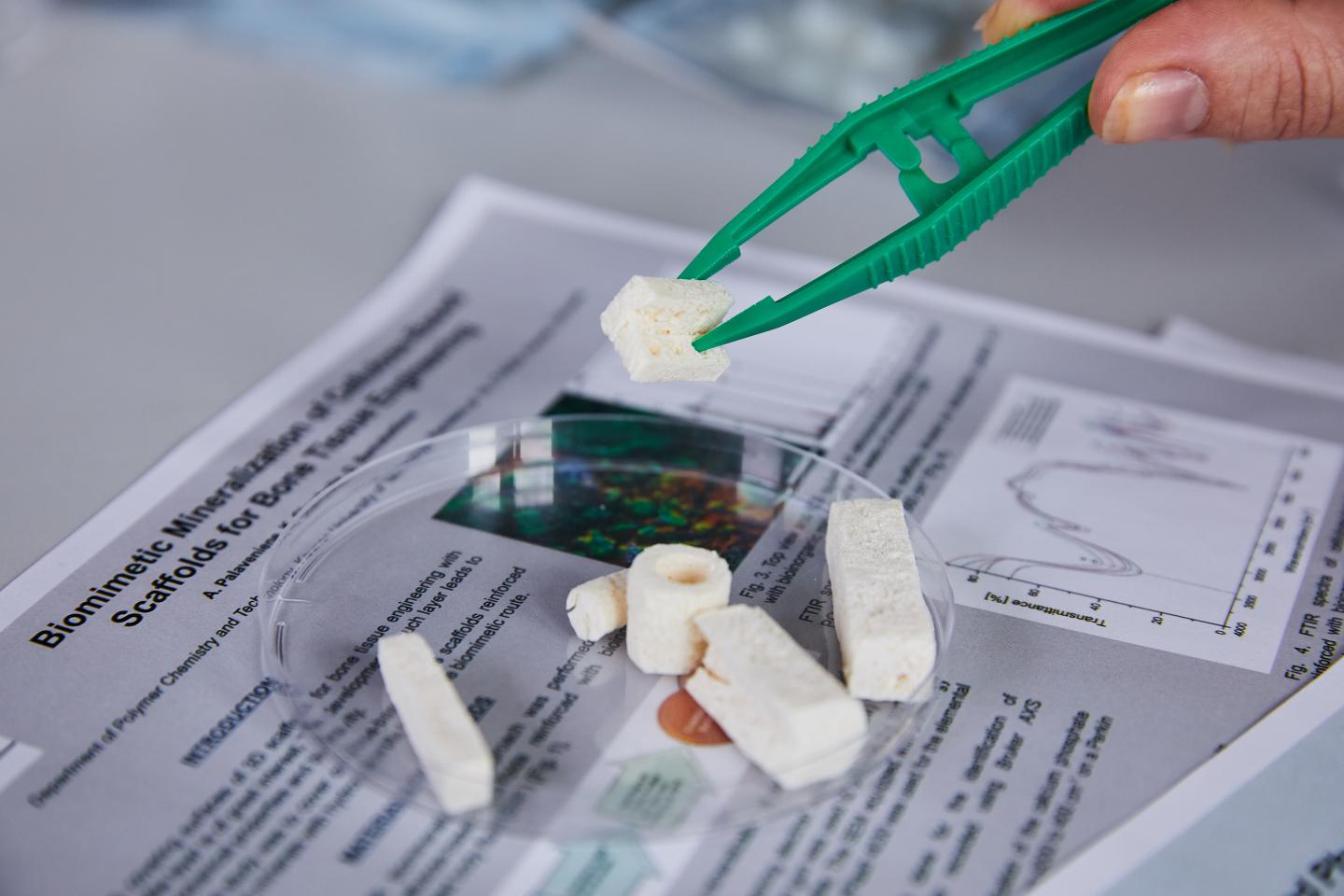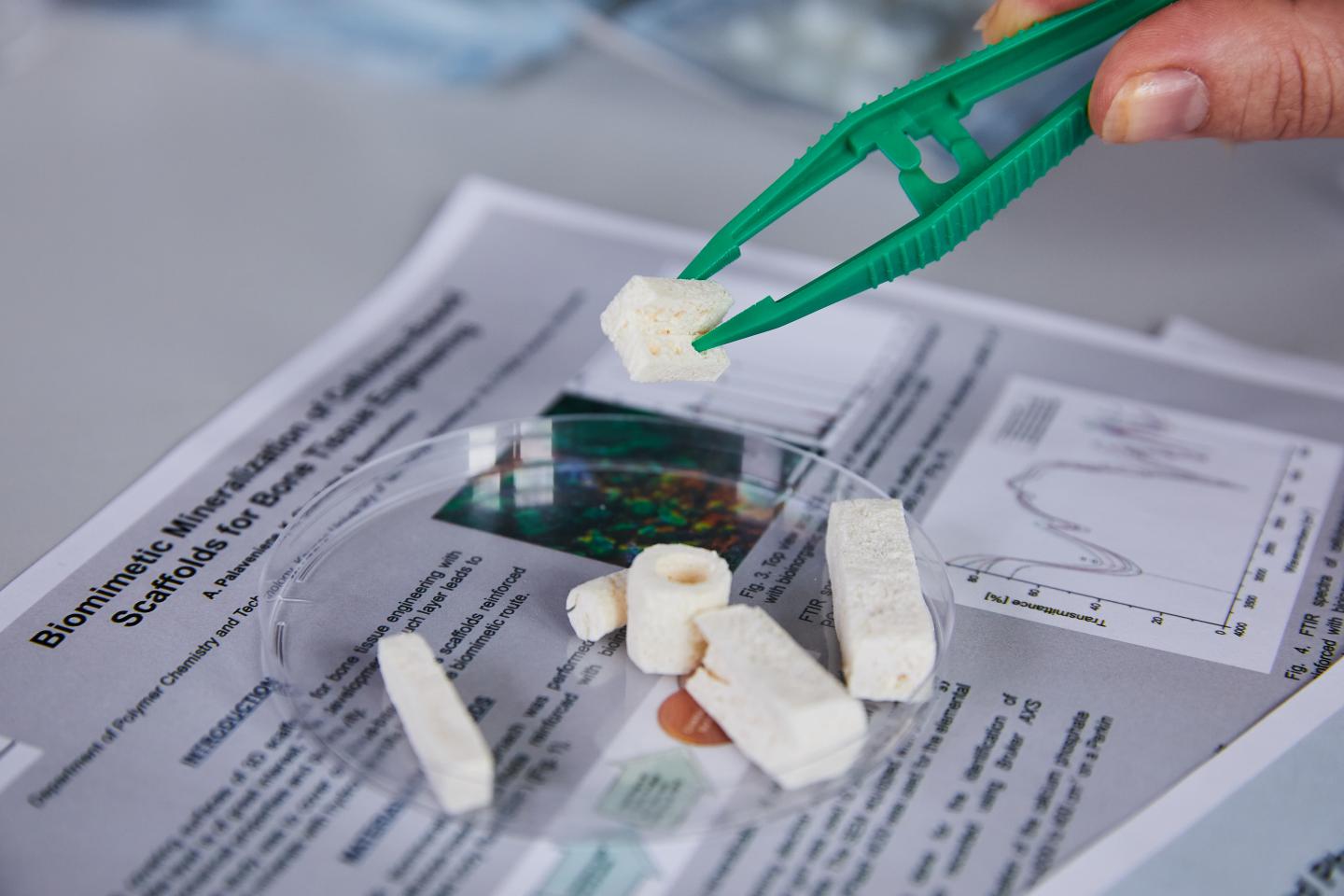
Credit: KTU
The group of researchers of Kaunas University of Technology (KTU) has developed several innovative applications of cuttlebone, natural biologically active material possessing bone and wound healing properties. The products include natural bone implants, suppositories for treatment of haemorrhoids and wound gels. By removing protein from the cuttlebone, KTU researchers have solved the main challenge connected to the usage of marine-derived materials – risk of side effects, such as allergic reaction of potential users.
Although cuttlebone has been used in traditional Chinese and Indian medicine for numerous purposes, its usage in contemporary medical practice is unknown. According to KTU researcher Alisa Palaveniene, who has been investigating cuttlebone properties and its potential applications in healthcare, there is no sufficient research-based knowledge on cuttlebone's exact elemental composition.
"Recently there has been a renewed interest in possible cuttlebone usages in bone tissue engineering and other areas. However, there is lack of research in regards to the possible side effects of this marine-derived material on human organism", says Dr. Palaveniene, researcher at KTU Faculty of Chemical Technology.
She reminds the main principle of medical professionals "First do no harm" and says that although naturally derived materials are often very efficient in healing medical conditions, thorough research is essential in every case.
"In cuttlebone, calcium carbonate comprises up to 90 % of its composition, but what it makes extremely valuable is aragonite, β-chitin and the abundance of different bioinorganic elements, such as magnesium, strontium, iron, even trace amounts of copper and zinc. All these elements are naturally combined by their optimal amounts in the bone structure. Their existence increases the bioactivity of any biomedical products containing cuttlebone", explains the researcher.
Dr. Palaveniene investigated multiple cuttlebone applications in biomedicine and pharmaceutical engineering. For oral surgery purposes, together with the KTU researchers' team she designed cellulose-based scaffolds with cuttlebone filling and calcium alginate capsules for small-sized bone defects in oral cavity containing cuttlebone materials. In both products, the two main components used are of natural origin. This means that they are biodegradable, naturally disappear and integrate into the human organism during healing process.
"Cuttlebone in the scaffolds or in the capsules is needed for osteoblasts' proliferation, i.e. bone cells to recognize that this is the place for synthesizing new cells and growing new bone. After cellulose and calcium alginate disintegrates, in the place of the cavity there is a new bone formed. As all the components in the products are natural, their bio-degradation products are harmless to human organism", says Dr. Palaveniene.
The two pharmaceutical cuttlebone products developed by the KTU researchers are gel, which can be used for the treatment of superficial wounds, and suppositories for treatment of haemorrhoids. Previously a pharmacist, Dr. Palaveniene is well aware of the popularity of biopharmaceutical products among the customers: "The suppositories containing shark liver oil used to always disappear first from the shelves of my shop".
The researcher maintains that the reasons behind non-existent commercial healthcare products containing cuttlebone are their possible side effects, such as allergies, potential heavy metal contamination and contamination by other organic pollutants from the sea.
"In my research, one of the tasks was removal of the traces of the protein tropomyosin found in cuttlefish muscle tissue, which amino sequence is slightly different from human. Some people have hypersensitivity to this protein and therefore can develop allergic reactions in contact with it", explains Dr. Palaveniene.
Usually, to remove protein from structures alkaline hydrolysis is being used. However, this method changes the bioinorganic composition of the cuttlebone. Using cutting-edge equipment available in contemporary research laboratories the KTU scientist has developed an alternative method for removal of tropomyosin residues from cuttlebone.
Moreover, Dr. Palaveniene has found no traces of biologically unfavourable heavy metals, such as silver, cadmium, lead, nickel in dorsal nor lamellar parts of cuttlebone, and after a thorough analysis of scientific literature on the topic she concluded that there was no organic pollution detected in this seaborne material. Cuttlefish life-span is comparably short – up to 2-3 years.
Ex vivo research with live cells was conducted in collaboration with V.N. Karazin Kharkiv National University (Ukraine), Charles University (Czech Republic) and Izmir Institute of Technology (Turkey). The results show that cuttlebone usage in bone tissue engineering is highly compatible with human organism, and that human bone cells are inclined to attach themselves and to grow bone tissue on the surface of the scaffold. It was also determined that the cuttlebone is non-toxic for keratinocytes, the main cell type in epidermis, the outer layer of skin.
Cuttlebone is naturally found along the coasts of East and South Asia, Western Europe, and the Mediterranean, as well as all coasts of Africa and Australia. Most commonly cuttlebone debris is used as bird food, rarely for jewellery making.
###
Video: https://youtu.be/NEuXOiNdKng
Media Contact
Aldona Tuur
[email protected]
370-612-55857
@ktunews
Original Source
https://en.ktu.edu/news/ktu-researchers-contemporary-medicine-might-find-cuttlefish-bone-useful/





